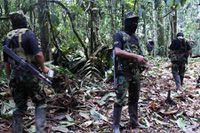Wechua Spring: Difference between revisions
| Line 58: | Line 58: | ||
==Operation Custodian== | ==Operation Custodian== | ||
As the security situation in the western regions of the Wechua Nation deteriorated, the Caputian Government, under the administration of [[Royston Merrick]], authorised an intervention to secure the [[Franja Transversal del Oeste]], a tribal region located between Caputia and Wechua under the direct administration of the [[Military of the Wechua Nation]], whilst simultaneously sealing the border between the Caputian state of San Luis and the frontier city of Apurimaq, heartland of the leftist rebellion. | |||
Ostensibly [[Operation Custodian]], beginning on 05.XII.1662 was intended to stabilise the common Caputia-Wechua frontier and permit the ''Kuriquinga Wamani'' (Wechu: "Vulture Corps") to redeploy against the insurgency. However the unilateral and uncoordinated nature of the sudden Caputian intervention, spearheaded by the 3rd Manoeuvre Army resulted in a number of bloody confrontations and weeks of subsequent skirmishing until a demarcation line following the border between the Franja and Wechua proper was established. | |||
==The Soviet Offensive== | ==The Soviet Offensive== | ||
Revision as of 10:39, 23 July 2018
| The Wechua Spring | |||||||
|---|---|---|---|---|---|---|---|
  [Top] The Grito of Apurimaq, the first demonstration in the Wechua Spring. [Bottom] Kʼanchaq Ñan Insurgent Troops. |
|||||||
|
|||||||
| Factions | |||||||
| Communist Soviet of the Wechua Nation; Social Democrat Club; Kʼanchaq Ñan. | ESB Group (Keltia) Supported by: Raspur Pact (Logistical only) |
||||||
| Commanders and leaders | |||||||
| Pacha Pinchi (CSWN); Awak Huanca Cocha (Social Democrat); Jaillita Pinto (KÑ). | HM Manco Cápac; Kayara Mayhuasca Soncco; General Phakchay Chaupin. |
||||||
The Wechua Spring, also referred to as the Wechua Revolution, is an ongoing armed conflict between the government of the Wechua Nation and the insurgent Kʼanchaq Ñan (Shining Path) guerilla group, which is the armed wing of the Communist Soviet of the Wechua Nation (known as the CSWN, or the Ceswan).
The Wechua Spring began as a wave of both violent and non-violent demonstrations, protests, and riots in 1662 AN in the cities of Apurimaq and Rimarima, organized by the Social Democrat Club and the Communist Soviet of the Wechua Nation. These protests gained lots of support due to dissatisfaction with the government of the Inkap Ratin Kayara Mayhuasca Soncco, steep increases in the prices of food and fuel, and high youth unemployment. Violent clashes between protestors and government forces in these cities triggered larger demonstrations in other cities like Parap, Auquimarca, and Huichajanca.
After a year of fighting between insurgent guerrilla groups aiming to overthrow the Sapa Wechua, negotiations between the Communist Soviet of the Wechua Nation and other factions with the Wechua Government led to the Wechua Peace Accords and to a Constitutional Convention that enacted a new Constitution that instituted many liberalizing reforms while maintaining the monarchy, and initiated the Wechua Deal, a national modernization and infrastructure project for Wechua Nation. The new Constitution was approved by a national Constitutional Referendum.
Background
State of the Wechua Economy
The Wechua Labor Movement
Wechua Political Realities
Grito de Apurimaq
Bloody Sunday
Cabildo Abierto
Soviet Insurgency
Operation Custodian
As the security situation in the western regions of the Wechua Nation deteriorated, the Caputian Government, under the administration of Royston Merrick, authorised an intervention to secure the Franja Transversal del Oeste, a tribal region located between Caputia and Wechua under the direct administration of the Military of the Wechua Nation, whilst simultaneously sealing the border between the Caputian state of San Luis and the frontier city of Apurimaq, heartland of the leftist rebellion.
Ostensibly Operation Custodian, beginning on 05.XII.1662 was intended to stabilise the common Caputia-Wechua frontier and permit the Kuriquinga Wamani (Wechu: "Vulture Corps") to redeploy against the insurgency. However the unilateral and uncoordinated nature of the sudden Caputian intervention, spearheaded by the 3rd Manoeuvre Army resulted in a number of bloody confrontations and weeks of subsequent skirmishing until a demarcation line following the border between the Franja and Wechua proper was established.
The Soviet Offensive
The Grito de Parap
Alexandrian Uprising
Soncco Government Falls
Operation Mustang
Caputian Support to Wechua Government
The Normark-Parap air bridge
Constitutional Convention
The March of Manco Cápac
El Cabildo Real
Wechua Peace Accords
The Night of Revenge
Constitutional Referendum
Modernization of the Wechua Nation
The Wechu Deal
Period of National Reconciliation
Aftermath
See also
- The Wechua Nation, Forum.